


JOHN HENRY KNIFTON 1853-1924
Lieutenant Colonel, bookkeeper, and travel agent
KATE LOUISA MAY 1851-1930
By Kevin Knifton 17th September 2022
Updated 12th October 2023
John Knifton was born on 9th February 1853 in London, the third child and only son of William and Susannah Knifton. His father William was a city missionary and in 1861 the family was living at 17 Lucan Place in Shoreditch. His birth was registered as 'John Knifton'.
When John was 12 years old, in 1865 the family emigrated to Canada, and by 1871 they were living in St Georges Ward, Toronto. John was as a law student, while his father found work as a cook. Two years later, both John and his father were working as cooks, working and/or living on Strachan Avenue East side, described on the assessment roll as being 'between railroad tracks'. The land was owned by the 'Dominion Government at Immigration Office'. William is noted as having two horses and two dogs.
By 1873, John was referring to himself as John Henry Knifton.
Between 1873 and 1876, John began working as an assistant bookkeeper for the Rice Lewis and Co. hardware store on King Street, Toronto. He was still working there 1877 when, on 20th June, he married Catherine Louisa May at the Metropolitan Church, Toronto. Their marriage record notes that John was an Episcopalian while Catherine was a Methodist. This was a double-wedding ceremony, with John's younger sister Susan Paulina Knifton marrying Catherine's brother John James Paul May.
Catherine, known as Kate, was born on 8th October 1851 at Illogan, Cornwall, England. Her name was registered as Catherine Paul Passmore, the daughter of Samuel May Passmore and his wife Sarah (née Paul). At this time her father was a master saddler but would later become a physician known as Dr Samuel Passmore May. The family emigrated to Canada in 1853 and here they started using the surname May, being the maiden name of Samuel's mother Elizabeth. Samuel used 'Passmore' as his middle name. On 1st September 1864, when Kate was 13 years old, her mother Sarah died within a month of giving birth to a son. Her cause of death was noted as 'confinement', and on 1st December 1864 her father, now Samuel Passmore May, married Harriet Louisa Wilton. This may be why Kate became known as Kate Louisa May rather than Kate Paul May.
John and Kate's first child, Herbert Samuel Knifton, was born in Toronto on 10th May 1878. At this time, John was working as a bookkeeper and the family appear to have lived with Kate's parents at Bathurst Street. Four adjoining properties were also owned by Kate's father Samuel May. A year later they are recorded as being in the St Patrick Ward of Toronto at Woolsey Street Intersects, the owner of the property, like several others, being Samuel May.
John and Kate's second child, Florence May Knifton, was born on 13th October 1879 in Toronto. At this time John was working as an accountant and the family were living at 7 Douce Court Road, although a year later they had moved to Cedar Street Intersects in St Stephen's Ward.
Susie Ethel Louise Knifton, John and Kate's third child, was born on 18th March 1881. The family were living at 460 Adelaide Street West, Toronto, and John was working for Christie Kent & Co. on Victoria Street East Side. However, Susie died of diphtheria on 5th March 1886 and two weeks later, on 20th March, their 6 year old daughter Florence also died of the same infection. Susie and Florence's bodies were initially placed in a vault at Necropolis Cemetery, from where they were taken for burial at the nearby Mount Riverside Cemetery on 30th March. The location of their grave can be seen here. The burial plot was owned by Messrs Saunders, May, and Knifton, and four other children, all of whom had died from diphtheria, were buried in the same plot that day: Bessie Pauline May (aged 7), the daughter of John's sister Susan Paulina, and William Knifton Saunders (aged 7), John A Saunders (aged 3) and Selina A Saunders (aged 1), the sons and daughter of John's sister Ada Josephine Saunders.
By 1887, John and Kate were living at 1 Seaton Street where on 22nd June their fourth and last child, Hiram Paull Knifton, was born.
On 6th August 1891, John was one of 296 passengers on the SS Vancouver which sailed from Liverpool to Montreal. His occupation was recorded as 'Gent' and he is recorded as being single. He may have been travelling with a Lieut. J.L. Mcavity whose name is next to his on the passenger list.
In 1892 or 1893, John and Kate moved 150 miles north from Toronto to Parry Sound. This move may have been the result of John's promotion to Captain in the Queen's Own Rifles.
Queen's Own Rifles of Canada
The Queen's Own Rifles of Canada [QOR] was a voluntary infantry reserve of the Canadian Army, whose members were known as riflemen with expert marksmanship. In a 1912 document, John wrote that he joined the QOR in November 1869. However, the Regimental records show he enrolled as a Private on 9th March 1870. John joined Number 5 Company which later became known as E Company. The Militia Act of 1868 required all men to be at least 18 years old, and for volunteers to commit to a service period of three years. John was 17 years old but gave his age as 19, and would remain with the QOR for over 20 years.
John would have devoted many of his weekends and evenings to the QOR. Records show that he attended each annual drill held from 1871/72 (as part of Number 5 Company) to 1893/94 (as part of C Company), lasting from one weekend to almost two weeks. The Regimental Orders record him being on duty with other men at the Rifle Range on many occasions, progressing from 'supernumerary' to 'subaltern' and then later to 'Captain' on a typical three-man team. He was also a member of several committee's for the QOR.
Between 1870 and 1894 John progressed from Private to Captain in the 2nd Regiment/Battalion of the QOR. An insight into his experiences can be seen from the Regimental Orders of the 2nd Battalion of the QOR.
2nd Regiment/Battalion
John took part in the annual drill of 1871/72 which was held at Niagara, during which, on 13th June 1872, he was promoted from Private to Corporal in E Company. He took part in the 1872/73 annual drill, and on 13th December 1874 John was promoted from Corporal to Sergeant. The net rates of pay per diem in 1874 were $0.60 for a Private and Corporal, and $0.70 for a Sergeant. A Captain's rate was £2.83
On 17th May 1876, John was promoted from Sergeant to Colour Sergeant. On 9th October 1878 he was awarded a 'Good Service Badge' for six years' service (which he had attained in 1876), and on 2nd April 1879 he received 'The Crown and Cross' badge for nine years' service.
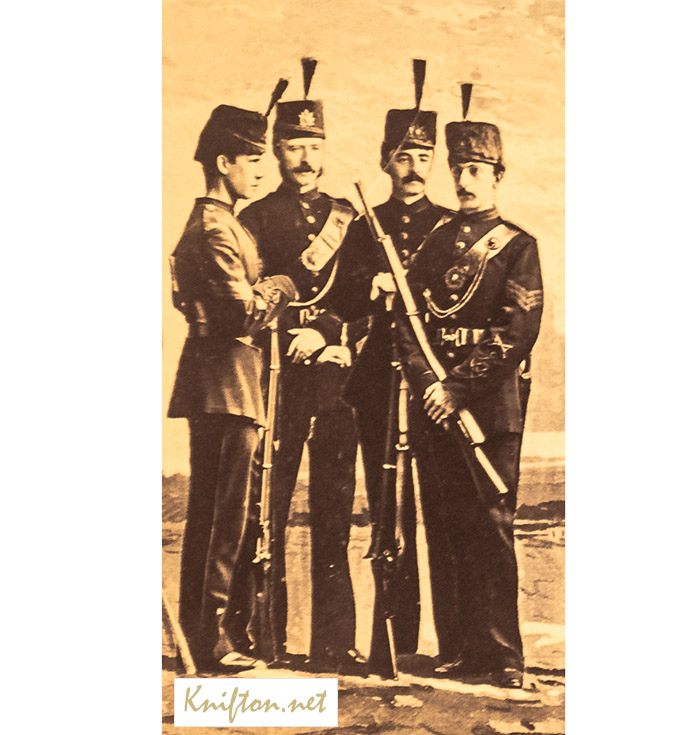 |
John Henry Knifton (third right)
Queen's Own Riffles Company 5, 1878
An entry in the Regimental Orders book dated 8th October 1879 includes John in a list of men who 'having made the necessary number of points in accordance with Regimental Order number 6 of 28th May last are hereby declared Marksmen for the ensuing year and are entitled to wear the distinctive badge of such'. John is noted as a 2nd Class Marksman of E Company. Four years later on 24th October 1883, John qualified as a First Class Marksman. However, the following year he qualified as a Second Class Marksman, but in 1885 qualified again as a First Class Marksman.
On 28th October 1885, John was promoted from Colour Sergeant to Second Lieutenant and in order number 3 dated 12th May 1886 from Toronto Headquarters, '2nd Lieut J H Knifton will act as Instructor of Musketry until further orders.'
The regiment marched from Toronto to Orillia for camp on 22nd May 1886, and at 10 p.m. the following day left Orillia to return to Toronto. On 28th October 1886, John was promoted from Second Lieutenant to Lieutenant.
John became a member of the QOR Rifle Committee which produced the Rules and Regulations for Rifle Practice for Season 1887. He is listed as a member of the committee for the same document the following year, and under 'Instructor of Musketry' for seasons 1888 and 1889 there was only one name; 'Lieut. J. H. Knifton'.
John was granted one week's leave of absence from the QOR to attend the Annual Prize Meeting of the Dominion Rifle Association which was held in Ottawa from 1st September 1888. Being granted such leave meant that John would continue to secure credit for all regimental parades held during his absence. He was also granted ten days leave the following year to attend the same event in Ottawa.
John continued as a member of various committees of the QOR, including those for the Annual Rifle Match held on the Garrison Common Rangers on Saturday 11th October 1890.
On Saturday 16th May 1891, John was part of the '1st Team' in the first competition of the Canadian Military Rifle League. We don't know how he fared. At 3 p.m. on the following Saturday, John was part of the parade which marched from the QOR Drill Shed to Younge Street dock via East Market and King Street, where he boarded the Chicora steamer to Niagara. Here the Battalion held camp for the weekend.
On 16th October 1891, John was promoted from Lieutenant to Captain, and from 21st October held Command of C Company. There were 60 men in C Company, including John. The 1892 season's leaflet for the Rules and Regulations for Rifle Practice show that the committee was now headed by 'Captain J. H. Knifton, President', and the leaflet for the Annual Rifle Match held on the Lake Shore Ranges on 22nd October 1892 included in the committee 'Capt. J. H. Knifton, Chairman'.
As part of the 2nd Battalion, in May 1892, John joined the annual camp which was held at Owen Sound. Their order stated that 'The Regiment will parade in "Marching Order" without water bottles on Saturday, May 21st, at 9 p.m., and will embark for Owen Sound, from C.P.R. Station, North Toronto. Signal men will not carry rifles. Route from Drill Shed via Jarvis, Bloor and Yonge'.
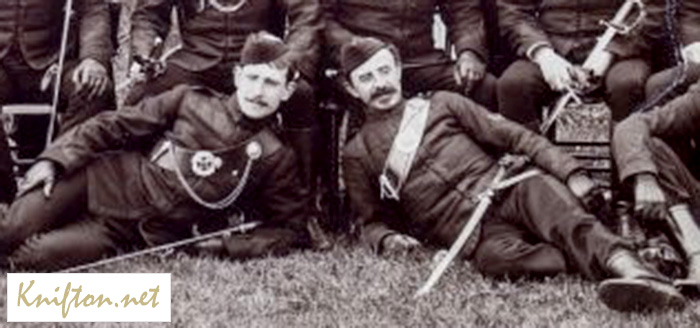 |
Captain John Henry Knifton (right), Owen Sound camp, 24th May 1892
A record of drill pay for 1893 shows that John received $33.84 for 12 days between 1st July and 15th November, i.e. a rate of $2.82 per day.
On 20th April 1894, Captain John Knifton was transferred from the 2nd Battalion of the QOR to the 36th Battalion.
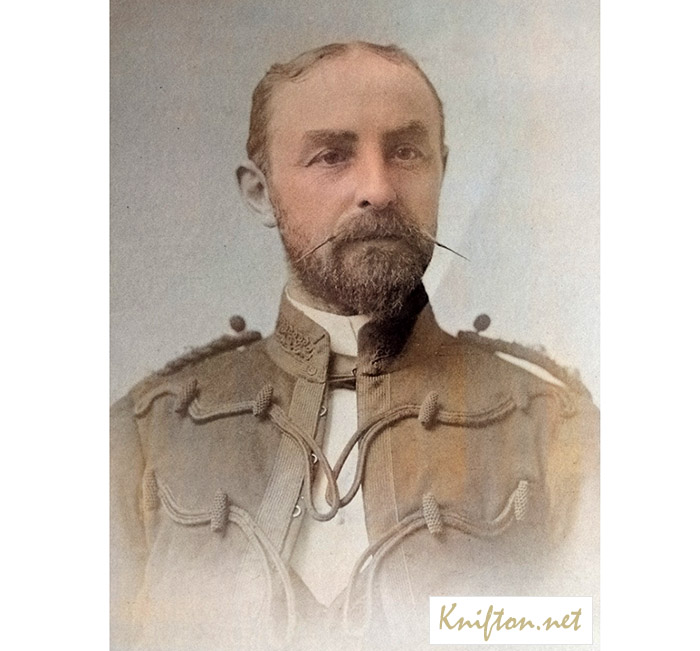 |
Captain John Henry Knifton, Officers photograph, 1893
Parry Sound, Mason, and the 36th Battalion
In 1893 John, Kate, and their sons Herbert and Hiram moved to River Street in Parry Sound. John was working as an agent for the Commercial Union Assurance Company and the London Guarantee & Accident Company. John also became the treasurer for Parry Sound, perhaps shortly after 1894: 'The report on the municipality's finances for 1894 by auditors John Henry Knifton and A.C. Neff was also highly critical of the practices of town treasurer Walter Read Foot'1.
Also in 1893, John became affiliated with the Parry Sound Masonic Lodge. He had become a member of the Masonic Lodge of Toronto in 1884 and attended the Twenty-ninth Annual Communication of the Grand Lodge of Ancient, Free and Accepted Masons of Canada, held in the Horticultural Gardens of Toronto on Wednesday 9th July 1884. Records of the meeting show the appointment of 'V.W. Bro. J. H. Knifton' to the office of Grand Senior Deacon. John attended these annual meetings most years. In 1886 he was included in a list of 'Past Grand Masters' with the title Past Grand Senior Deacon, and by 1898 he was the District Deputy Grand Master for 'Parry Sound Nipissing District No. 18'. At some point John became the secretary for the Granite Lodge of Parry Sound. Following a visit to the lodge on 30th November 1900, the Nipissing district official commented 'I was very much pleased to renew my acquaintance with R. W. Bro. Knifton, to whom this Lodge owes considerable, he being a valuable support, as strictness and precision is his hobby.' By 1902 John is referred to as 'Worshipful Master' and a report following a 1915 visit to the lodge by the Muskoka district official noted 'Col. Knifton is an admirable officer and has the books under his care in excellent shape. The Treasurer's books are also well kept, and show a good balance on hand. This is much the strongest lodge numerically and financially in the district, and splendid harmony prevails.' Unfortunately the Parry Sound lodge burned down in the 1950's and all their records were lost.
On 20th April 1894, John was appointed as Captain of Number 3 Company of the 36th Peel Regiment. The headquarters of Number 3 Company was in Cookstown, between Toronto and Parry Sound. The 36th Battalion was originally known as the Peel Regiment and was eventually amalgamated to form todays Lorne Scots. John is recognised as being one of the first members of The Lorne Scots.
From 5th April to 14th May 1898, Captain John Knifton attended the Royal School of Infantry at Toronto. His Certificate of Military Instruction-Infantry records that overall he attained 82.75% in the written section and 80.16% for the practical part, giving a total of 81.45½%
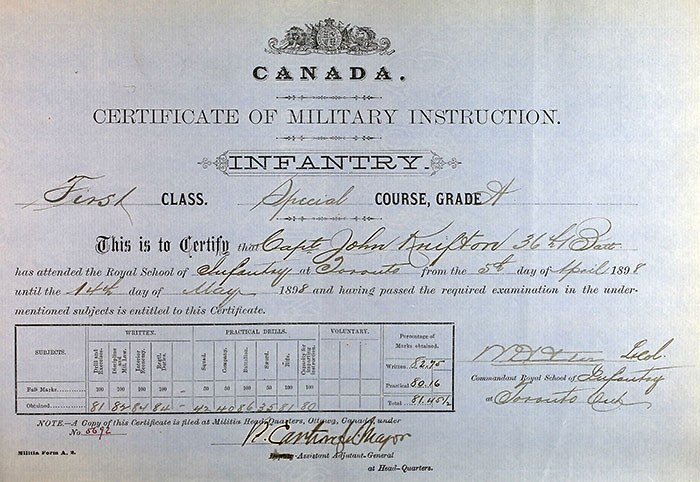 |
In 1899, John applied for the Canada General Service Medal for his service in the Queen's Own Rifles during the Fenian Raid of 1870. The Fenian raids were carried out by the Fenian Brotherhood, an Irish Republican organisation based in the United States, on British Army forts, customs posts and other targets in Canada. It was an effort to force the British government to withdraw from Ireland. Ontario was one place where the raids took place. John stated that at the time he was a Private and served at the Drill Shed, Toronto, from 1st May to 15th October 1870. His application was successful and John was awarded the medal, which is said to have had his name on the edge of it.
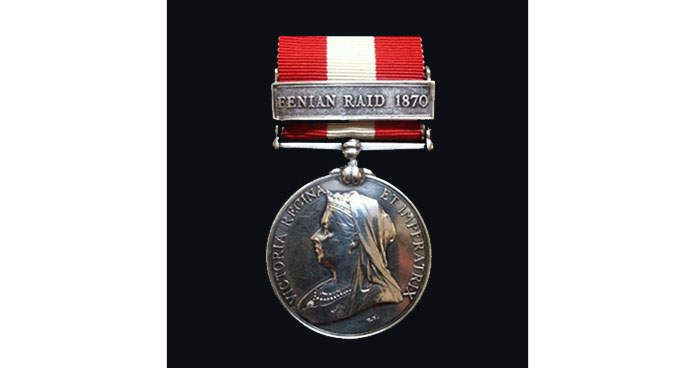 |
John attended the Royal School of Cavalry from 5th to 15th March 1901 and his Certificate of Military Instruction–Equitation shows that he passed the 'required examination' in the four subjects of Equitation (scoring 70/100), Sword Exercise (22/25), Stable Duties (20/25), and Fitting Saddlery (20/25). Overall he achieved 75%
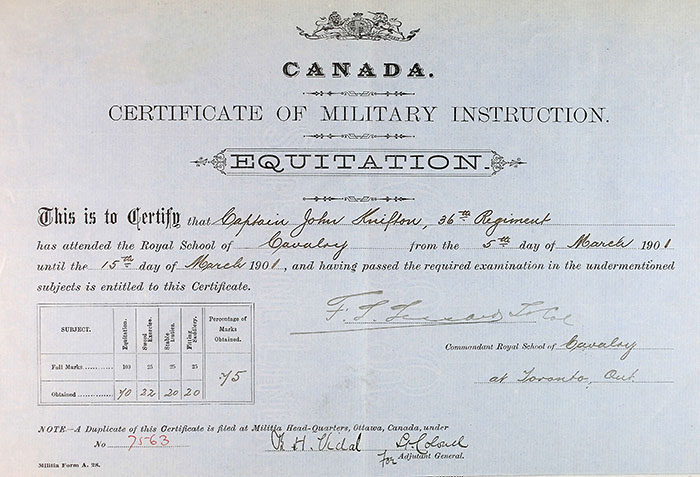 |
By 1901 John was promoted to 'Captain and Brevet-Major' of the 36th Regiment. John and Kate were still living in Parry Sound. John's father William, now a 75 year old widower, was also living with the family and working as an insurance agent, perhaps with John.
On 16th August 1902 John received the Colonial Auxiliary Forces Officers' Decoration. This decoration, with post-nominal letters 'VD' [Volunteer Officers' Decoration], was established in 1899 as recognition for long and meritorious service as a part-time commissioned officer in any of the forces of the British Colonies. It was awarded for twenty years of service. John's recorded service was stated as being '23 years, 5 months, 5 days'.
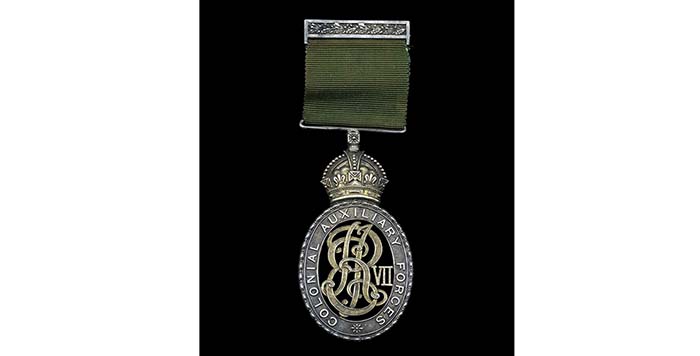 |
The Northern Fusiliers
In 1903 John was appointed as Lieutenant Colonel of the Northern Pioneers, also known as '23rd Regiment, The Northern Fusiliers'. 'The 23rd Northern Pioneers were the local regiment of Canada's pre-war militia, and had only recently been organized. In March 1903, the Department of Militia and Defence authorised the formation of a unit in the District of Parry Sound...Commanding the regiment was Lieutenant Colonel John Henry Knifton, Treasurer for the Town of Parry Sound. He had 24 years of militia experience with the Queen's Own Rifles of Canada and another nine years with the 36th Peel Regiment.'1
The Northern Pioneers was formed on 1st September 1903 and headquartered in Parry Sound. John commission Duncan F. Macdonald to create a badge to represent the regiment. The final badge includes a canoe, said to be a northern object. John went with the Northern Pioneers to Niagara-on-the-lake in June 1905.
Following a review of the towns financial affairs, John resigned as treasurer for Parry Sound in October 1908: 'The creation of Park Lane in 1908 necessitated the purchase of property by the municipality, and the total compensation paid out to residents adversely affected by the street closures exceeded the $1,700 paid by the CPR. On July 14, 1908, concerned residents...petitioned the provincial municipal auditor requesting an investigation of the town's financial affairs. Toronto chartered accountant Oscar Hudson spent several weeks in Parry Sound going through the ledgers kept by town treasurer John Henry Knifton before determining that there was a shortage of almost $4,000. Knifton made restitution and resigned in October 1908, but the special audit cost the municipality almost $1,200.'1
Also in 1908, John and Kate travelled to England, returning in November from London to Quebec on the SS Corinthian. They travelled in the second cabin and John gave his occupation as 'transportation agent'. The following year John travelled to Scotland, starting his return journey from Glasgow on 11th September on the SS Ionia bound for Montreal.
As Lieutenant Colonel, John retired from the 23rd Regiment, The Northern Fusiliers, in September 1909, being replaced by John Bellamy Miller, President of the Parry Sound Lumber Company.
John travelled to England in 1910. On 13th October 1910 'Colonel JH Knifton' left the Port of Avonmouth, Bristol on the SS Royal George bound for Quebec and Montreal. He travelled in first class on ticket number 133, and disembarked at Montreal, from where he made his way to Parry Sound. At this time he was working with his son Herbert as agent for the Commercial Union Assurance Co. Ltd., and as ticket agents for the Canadian Northern Railway, and Canadian Pacific and Ocean Steamship Lines.
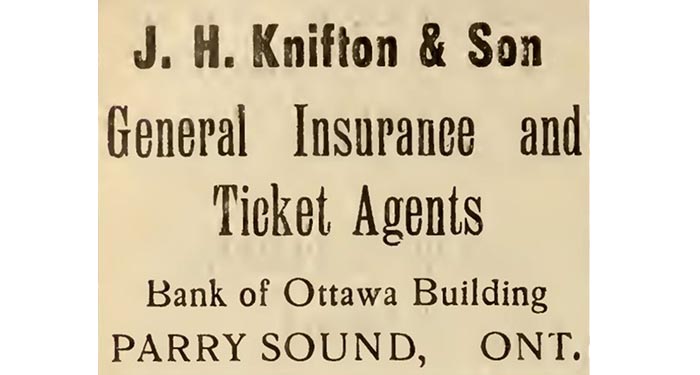 |
On 14th May 1912 John submitted an 'Application for Grant' under The Fenian Raid Volunteer Bounty Act. This Act was passed in 1912 and awarded veterans $100 for their military service. The applicant had to be in possession of the service medal for the Fenian Raid, which John had received, and was also required to submit a comrade's declaration attesting to the information in the application.
John wrote on his application 'I was enrolled in the 2nd QOR, No.5 & No. 3 and served with it at Toronto, Lt. Col. Sillmon in the Province of Ontario from November 1869 to June 1894'. However, the second page of the application, the 'Comrade's Declaration', was left blank. A letter to John dated 25th May 1912 from the Secretary of the Militia Department informed him that his application was being returned, advising that 'if you are unable to obtain a Comrade's Declaration or a declaration from anyone who personally knows of your service during the Fenian Raids, it will be necessary for you to send to the Department the best evidence you can procure of your service, when your application will be considered'.
John replied two days later, writing 'I do not know where I could obtain a Comrade's declaration...I have been in the force ever since...my name appears in the Militia List with crossed swords and as I have been notified that I am shortly to succeed to the command of the 10th Infantry Brigade.' He added that 'I am leaving for England within the next few weeks and will be away until the middle of October.' Under his name John gave his title as 'Lieut. Col. R.O.', showing he was a Retired Officer. John appears to have written again on 5th of November/December but this document does not survive.
In a letter to John dated 16th December 1912 he was informed that having been unable to provide a Comrade's Declaration his application was not successful. Moreover, the Companies which John served in had not been called out during in the Fenian Raids. If John had been defending the Drill Shed against a potential attack, this was not considered as qualification for the grant.
John travelled to England in the Summer of 1912, returning from Bristol on 21st August on the SS Royal Edward. He was one of 1070 passengers and again travelled in first class. He held ticket number 686 bound for Montreal.
In 1912 John began working as a collector of customs for the government office in Parry Sound.
It is not clear whether John took command of the 10th Infantry Brigade as he indicated he was going to do in his 1912 letter. However, it is thought that on 20th September 1913 he was appointed as the Commanding Officer, as Lieutenant Colonel, of 14th Infantry Brigade, Toronto, which he held until he retired from the position on 12th June 1920. He may have been promoted to Colonel during this time - the Masons report of 1915 noted above refers to him as Colonel. Also, the 100th anniversary Granite Lodge booklet is said to state that John was a Boer War Colonel, although I have not yet found a record which shows he was in this 1899-1902 campaign.
On 4th April 1914, Kate provided an affidavit in relation to a matter regarding 'John Paul (deceased)'. The affidavit referred to the family bible which was 'exhibit marked C.L.K.5' (Catherine Louisa Knifton). John Paul was Kate’s grandfather on her mother’s side, who died at Marazion, Cornwall on 27th April 1877 aged 84. He was a 'master currier' and probate for his effects was granted on 30 May 1877 to two of his daughters, Mary Edmonds and Paulina Thomasin Paul. John Paul and his wife Mary had at least nine children. Paulina died a spinster on 20th October 1912 and probate for her effects was granted at London on 15th November 1912 to Samuel Stephens and Albert Francis Hambly Stephens. It appears that following Paulina's death there was a dispute regarding the execution of John Paul's legacy. John Paul appears to have left some of his estate in trust which is likely to have stated that on the death of one or more of the beneficiaries, perhaps his daughters Mary and Paulina, the beneficiaries of the trust would become any of his other surviving children and any surviving issue of all of his children. A case was brought by one or both of the Stephen's (executors of Paulina's Will) against an Edmonds, likely Mary as the surviving trustee from John Paul’s Will. The case was heard in the Chancery Division of the High Court of Justice in London who issued an order dated 9th April 1913 allowing for John Paul’s children or grandchildren to come forward and 'prove their claims'. It is likely that Kate used the family bible to prove her ancestry, since it contains births, marriages, and deaths, of the Knifton and Passmore May families. It is not known if her claim was successful: the hearing for claims was originally scheduled for 13th October 1913 and later moved to 15th January 1914. Kate’s affidavit was dated 4th April 1914.
Around 1918 John was encouraging recruitment for the First World War: 'Later that night, prominent local citizens spoke at the Princess Theatre before a packed house. Lieutenant Colonel Knifton and Judge Francis Ronan Powell urged all able-bodied young men of the town to enlist at once'.1
John Knifton died on 5th September 1924 at his home on River Street, Parry Sound, and was buried at Hillcrest Cemetery on 8th September. He was 71 years old.
 |
After her husband's death, Kate continued to live at River Street where, on 5th July 1930, she died aged 78. Kate was interred with her husband at Hillcrest Cemetery two days later.
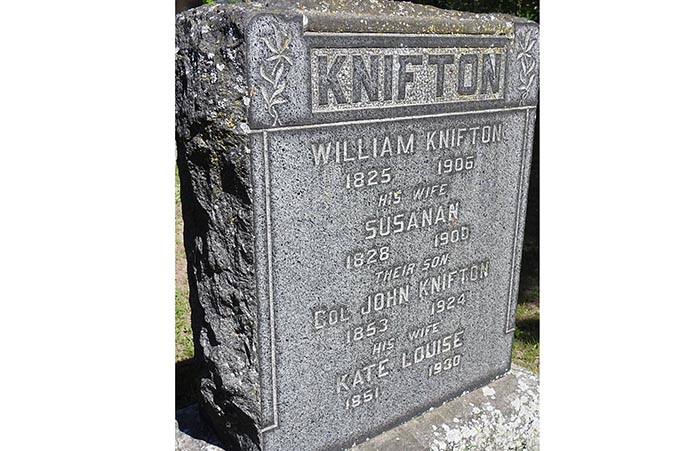 |
 |
1A. Haynes Parry Sound: Gateway to Northern Ontario (Natural Heritage/Natural History Inc., 2005)